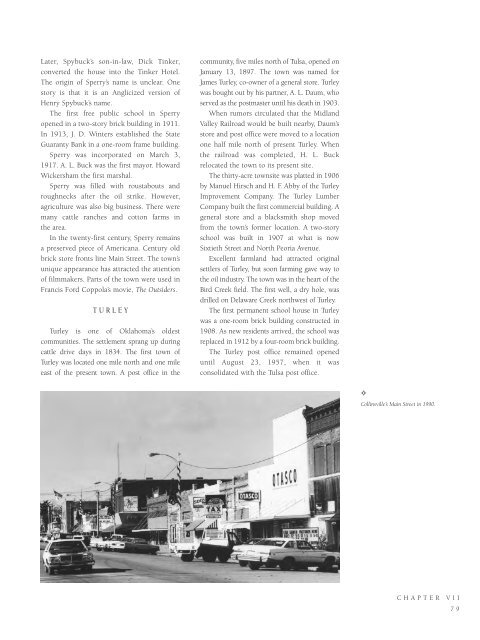Historic Tulsa
An illustrated history of the city of Tulsa, Oklahoma, paired with the histories of companies, families and organizations that make the region great.
An illustrated history of the city of Tulsa, Oklahoma, paired with the histories of companies, families and organizations that make the region great.
You also want an ePaper? Increase the reach of your titles
YUMPU automatically turns print PDFs into web optimized ePapers that Google loves.
Later, Spybuck’s son-in-law, Dick Tinker,<br />
converted the house into the Tinker Hotel.<br />
The origin of Sperry’s name is unclear. One<br />
story is that it is an Anglicized version of<br />
Henry Spybuck’s name.<br />
The first free public school in Sperry<br />
opened in a two-story brick building in 1911.<br />
In 1913, J. D. Winters established the State<br />
Guaranty Bank in a one-room frame building.<br />
Sperry was incorporated on March 3,<br />
1917. A. L. Buck was the first mayor. Howard<br />
Wickersham the first marshal.<br />
Sperry was filled with roustabouts and<br />
roughnecks after the oil strike. However,<br />
agriculture was also big business. There were<br />
many cattle ranches and cotton farms in<br />
the area.<br />
In the twenty-first century, Sperry remains<br />
a preserved piece of Americana. Century old<br />
brick store fronts line Main Street. The town’s<br />
unique appearance has attracted the attention<br />
of filmmakers. Parts of the town were used in<br />
Francis Ford Coppola’s movie, The Outsiders.<br />
TURLEY<br />
Turley is one of Oklahoma’s oldest<br />
communities. The settlement sprang up during<br />
cattle drive days in 1834. The first town of<br />
Turley was located one mile north and one mile<br />
east of the present town. A post office in the<br />
community, five miles north of <strong>Tulsa</strong>, opened on<br />
January 13, 1897. The town was named for<br />
James Turley, co-owner of a general store. Turley<br />
was bought out by his partner, A. L. Daum, who<br />
served as the postmaster until his death in 1903.<br />
When rumors circulated that the Midland<br />
Valley Railroad would be built nearby, Daum’s<br />
store and post office were moved to a location<br />
one half mile north of present Turley. When<br />
the railroad was completed, H. L. Buck<br />
relocated the town to its present site.<br />
The thirty-acre townsite was platted in 1906<br />
by Manuel Hirsch and H. F. Abby of the Turley<br />
Improvement Company. The Turley Lumber<br />
Company built the first commercial building. A<br />
general store and a blacksmith shop moved<br />
from the town’s former location. A two-story<br />
school was built in 1907 at what is now<br />
Sixtieth Street and North Peoria Avenue.<br />
Excellent farmland had attracted original<br />
settlers of Turley, but soon farming gave way to<br />
the oil industry. The town was in the heart of the<br />
Bird Creek field. The first well, a dry hole, was<br />
drilled on Delaware Creek northwest of Turley.<br />
The first permanent school house in Turley<br />
was a one-room brick building constructed in<br />
1908. As new residents arrived, the school was<br />
replaced in 1912 by a four-room brick building.<br />
The Turley post office remained opened<br />
until August 23, 1957, when it was<br />
consolidated with the <strong>Tulsa</strong> post office.<br />
✧<br />
Collinsville’s Main Street in 1990.<br />
CHAPTER VII<br />
79
















